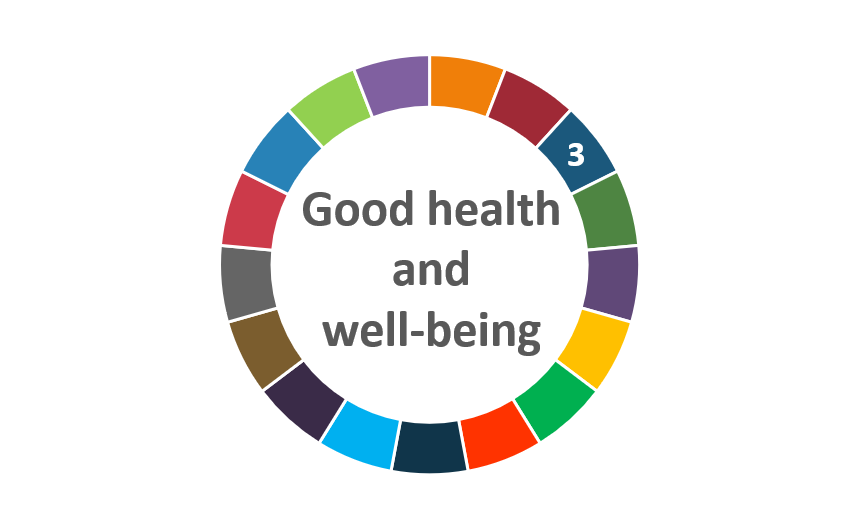
ΑΙhub.org
Good health and well-being: summarising AI and robotics in healthcare – diagnostics, personalised care, drug discovery, and more

In December 2020 we announced the launch of our focus series AI for Good: UN sustainable development goals (SDGs). Each month we pick a different sustainable development goal (SDG) and highlight work in that area. Following a terrific response to our first focus on “good health and well-being”, we bring you the first of our monthly summary articles where we provide a brief overview of the topic and some highlights from the series.

COVID-19
With the COVID-19 pandemic dominating our lives at the moment, research relating to the disease has rightly received considerable coverage in our focus series. In partnership with CLAIRE’s COVID-19 taskforce initiative we have brought you articles covering the formation of the taskforce, and about some of the research from the participants. You may also have seen the insightful video interviews with the topic leaders from the taskforce. The series started with Emanuela Girardi, and we’ve also heard from Davide Bacciu, and Ann Nowé.

Robotics
Early on in the pandemic there were reports of robots being used to assist in various ways. This website provides regular updates as to how robots are being used to help with the pandemic response. As of 15 January, there were 326 instances of robot usage in 45 countries. A recent IFRR colloquium discussed how robots have been successfully used and what is needed, both in terms of fundamental research and policy, for robotics to be prepared for the future emergencies. You can watch it here.
Looking at robotics in other areas of healthcare, we talked to Guillem Alenyà about his research into assistance robots. Guillem is the director of Institut de Robòtica i Informàtica Industrial, CSIC-UPC, in Barcelona. Together with Carme Torras (who’s work we covered in September on AIhub) he leads exciting projects in this space, including using robots to assist with cognitive training for dementia patients, feeding, dressing and cloth manipulation.

This video from the UK-RAS (Robotics and Autonomous Systems) Network demonstrates the shortlisted entries from their Medical Robotics for Contagious Diseases Challenge. It gives a flavour of the varied and innovative ways that robotic systems can aid us in medical settings.
Imaging and diagnostics
An area where the use of machine learning, and deep neural networks in particular, has come to the fore in recent years, is imaging and diagnostics.
In their recently published paper, Toward robust mammography-based models for breast cancer risk, the authors developed a machine learning model to predict breast cancer risk at multiple time points based on traditional mammograms.
Last year it was reported that researchers had used stimulated Raman histology and deep neural networks in brain tumor diagnosis.
Skin cancer diagnosis is another area where AI techniques have shown considerable promise. This perspective article from 2019 gave a good overview of what is possible, and also, what would need to be done to make sure that the technology works for everyone. Here is a study from 2020 which used a convolutional neural network (CNN) to predict malignancy and suggest primary treatment options.
Stephen Odaibo is using computer vision to look at the retina, from which the status of various aspects of your health can be determined. He has built a cloud-based AI platform that diagnoses diseases such as diabetic retinopathy, macular degeneration and glaucoma from pictures of the retina. Varun Gulshan et al made a study of Diabetic Retinopathy detection using a deep-learning model for patients in India.
Personalised care
One area of medicine that has been mooted as being particularly suited to the integration of AI systems is personalised care. The idea of being able to provide each patient with an individual care plan is highly desirable.
Suchi Saria, Johns Hopkins University, is working in this area and her goal is to use sophisticated computer science and the deluge of data available in healthcare and other settings to individualize patient care. Her work centres on enabling new classes of diagnostic and treatment planning tools. The study of observational time series data is key to making progress in this area.
Mihaela van der Schaar also talked about individualized care in her ICLR 2020 keynote talk. You can find a highlights video of this talk, put together by her lab, here.
The van der Schaar lab is working on numerous projects, not just personalised care. Read about their work on cystic fibrosis, Alzheimer’s Disease and diabetes. The key to success in this field of medicine and AI is in working with clinicians, and other stakeholders, every step of the way. The lab is hosting a series of engagement sessions to share ideas and discuss topics that will define the future of machine learning in healthcare. These discussion sessions were specifically for healthcare professionals (primarily clinicians and healthcare workers). You can watch to past sessions and find out about forthcoming sessions here.
Drug discovery
You probably saw the news towards the end of last year that DeepMind had built a model that predicted protein folding with impressively high accuracy. One of the many applications for this model is in drug discovery. The team at DeepMind are also looking into how protein structure predictions could contribute to our understanding of specific diseases, for example by helping to identify proteins that have malfunctioned and to study how they interact.
We’ve covered drug discovery in our focus series, reporting on how researchers at Rice University used deep learning to predict drug metabolites. In the summer of 2020, scientists at Leiden University published work presenting their workflow for finding unknown and innovative drug structures.

The search for new antibiotics hit the news in February 2020 as it was reported that MIT researchers had used a machine-learning algorithm to identify a powerful new antibiotic compound. In laboratory tests, the drug, called halicin, killed many disease-causing bacteria, including some strains that had been resistant to all existing antibiotics. In fact, it was this work (coupled with her work on breast cancer diagnosis) that earned Regina Barzilay the $1 million AAAI Squirrel AI award. You can read our coverage of Regina’s AAAI invited talk in which she described her work and talked about her research journey.
General articles
These articles may be of interest if you are keen to find out more about what is going on generally in the field:
AI in healthcare: A narrative review
A review of medical artificial intelligence
Artificial Intelligence in Medicine: Today and Tomorrow
Artificial intelligence in healthcare: review and prediction case studies

In The impact of artificial intelligence in medicine on the future role of the physician Abhimanyu S. Ahuja considers the role of AI-based systems in performing medical work in specializations including radiology, pathology, ophthalmology, and cardiology. He concludes that AI-based systems will augment physicians and are unlikely to replace the traditional physician–patient relationship.
This article Time to reality check the promises of machine learning-powered precision medicine provides a valuable reminder, noting that although “machine learning and precision medicine are genuine innovations and will undoubtedly lead to some great scientific successes … these benefits currently fall short of the hype and expectation that has grown around them.” They note that research in this area should undergo due scrutiny including a reality check on the promises of machine learning-powered precision medicine and an enhanced focus on the core principles of good data science.
In this paper Machine learning and artificial intelligence research for patient benefit: 20 critical questions on transparency, replicability, ethics, and effectiveness, the authors propose that interdisciplinary groups pursuing projects involving machine learning and AI for health would benefit from explicitly addressing a series of questions concerning transparency, reproducibility, ethics, and effectiveness. They pose 20 questions in the paper with the idea that these will provide a framework for research groups, peer reviewers, patients, clinicians and policy makers to critically appraise where new findings may deliver patient benefit.
Bias
An important topic to consider is bias, how and when this arises, and what we can do to mitigate this.
In their paper Dissecting racial bias in an algorithm used to manage the health of populations, Ziad Obermeyer et al. examine the outputs and inputs of an algorithm that predicts health risk, and influences treatment, of millions of people. They found evidence of racial bias such that Black patients assigned the same level of risk by the algorithm are sicker than White patients. You can also read Ruha Benjamin’s perspective article on this paper, titled Assessing risk, automating racism.
Researchers talk about geographic bias in medical AI tools in this news article.
Potential biases in machine learning algorithms using electronic health record data considers biases related to missing data and patients not identified by algorithms, sample size and underestimation, and misclassification and measurement error.
As part of the NeurIPS 2020 workshop Machine Learning for Health (ML4H): Advancing Healthcare for All, Judy Gichoya gave an invited talk on “Operationalizing fairness in real life clinical setting: A grand challenge”. You can watch the talk here.

The sustainable development goals in general
Finally, this review article from January 2020 assesses the role of AI in achieving the sustainable development goals. The authors found that AI had the potential to enable the accomplishment of 134 targets across all the goals, but it may also inhibit 59 targets. They noted that the fast development of AI needs to be supported by the necessary regulatory insight and oversight for AI-based technologies to enable sustainable development. Failure to do so could result in gaps in transparency, safety, and ethical standards.
List of the articles in the focus series
Here is a list of the content posted to date. The focus series remains open to contributions and these will be added as and when they are published. You can also click here to see the full collection.
Interview with Guillem Alenyà – discussing assistive robotics, human-robot interaction, and more
Using AI-enhanced music-supported therapy to assist stroke patients
The CLAIRE COVID-19 Initiative: a bottom-up effort from the European AI community
CLAIRE COVID-19 taskforce webinar
High-performance computing and AI team up for COVID-19 diagnostic imaging
Webinar on “Macro dynamics predictions in COVID-19 crisis, explained by micro intentions”
CLAIRE COVID-19 Initiative Video Series: Meet the Team Leaders – Emanuela Girardi
CLAIRE COVID-19 Initiative Video Series: Meet the Team Leaders – Davide Bacciu
CLAIRE COVID-19 Initiative Video Series: Meet the Team Leaders – Ann Nowé
CLAIRE COVID-19 Initiative Video Series: Meet the Team Leaders – Jose Sousa
Opportunities for machine learning use in cystic fibrosis care
Prediction of drug metabolites using deep learning
Computer vision app allows easier monitoring of glucose levels
Deep learning microscope for rapid tissue imaging
#AAAI2021 invited talk – Regina Barzilay on deploying machine learning methods in cancer diagnosis and drug design
Researchers use deep learning to identify gene regulation at single-cell level

tags: Focus on good health and well-being, Focus on UN SDGs










